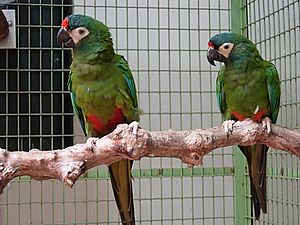Blue-winged macaw facts for kids
Quick facts for kids Blue-winged macaw |
|
|---|---|
 |
|
| Conservation status | |
| Scientific classification | |
| Genus: |
Primolius
|
| Species: |
maracana
|
 |
|
The blue-winged macaw (Primolius maracana) is a small type of macaw. People sometimes call it a "mini-macaw." It is also known as Illiger's macaw, named after a German bird expert, Johann Karl Wilhelm Illiger. These colorful birds live in central and eastern South America. Blue-winged macaws can live for a very long time, sometimes up to 50 or 60 years!
Contents
What Does It Look Like?
This macaw is about 36 to 43 centimeters (14 to 17 inches) long. It has a black beak and a long tail. Most of its feathers are green. The top of its flight feathers and wing covers are blue, which is why it's called the blue-winged macaw. The underside of its wings is yellowish.
Its tail tip, the top of its head, and its cheeks are bluish. It also has a red patch at the base of its tail and on its belly. The eyes of this macaw are amber-colored. The skin on its face is usually yellowish, but it can turn white when the bird is kept as a pet. Unlike some other macaws, the blue-winged macaw has a red lower belly and a red lower back. When flying in the wild, they have a special "jerky" way of moving.
Where Do They Live and What Do They Eat?
Blue-winged macaws live in eastern and southern Brazil and eastern Paraguay. They used to live in parts of Argentina and Bolivia too. These birds prefer to live in forests that stay green all year or forests where trees lose their leaves in certain seasons. They especially like forests found along rivers.
Their main food is seeds from different plants. They also enjoy eating various fruits and nuts.
How Do They Have Babies?
Blue-winged macaws are ready to have babies when they are between 2 and 4 years old. The female macaw usually lays two eggs. These eggs hatch after about 29 days.
Young blue-winged macaws learn to fly when they are about 11 weeks old. After they learn to fly, they stay with their parents for about a year. This helps them learn important skills for living in the wild. In some parts of Brazil, they have their babies between December and February.
Why Are They in Danger?
The biggest problem for blue-winged macaws is deforestation. This means their forest homes are being cut down. In the past, many of these birds were also caught and sold as pets. For example, between 1977 and 1979, many macaws were brought to the United States from Paraguay.
Because of these problems, the number of blue-winged macaws went down in some areas. Farmers in Argentina even killed some because they thought the birds were pests. Because of this, the bird was once considered "vulnerable," meaning it was at high risk of becoming endangered. However, thanks to conservation efforts, their numbers have increased in some areas of Brazil. Now, they are considered "near threatened," which means they are still at risk but not as much as before.
Blue-winged Macaws as Pets
Sometimes, people keep blue-winged macaws as pets or in large bird enclosures called aviaries. These birds are very social and love to fly. They do best when they are with other birds, either other blue-winged macaws or different types of parrots. They need a lot of space to fly around.
Blue-winged macaws also love to chew! Owners need to give them wooden toys to chew on. This helps keep the birds busy and stops them from chewing on other things. Breeding these birds in captivity is important to help their numbers grow. If you have a blue-winged macaw as a pet, it can become very close to you. Some macaws can even seem to understand how their owner is feeling.
Images for kids
See also
 In Spanish: Maracaná cara afeitada para niños
In Spanish: Maracaná cara afeitada para niños




